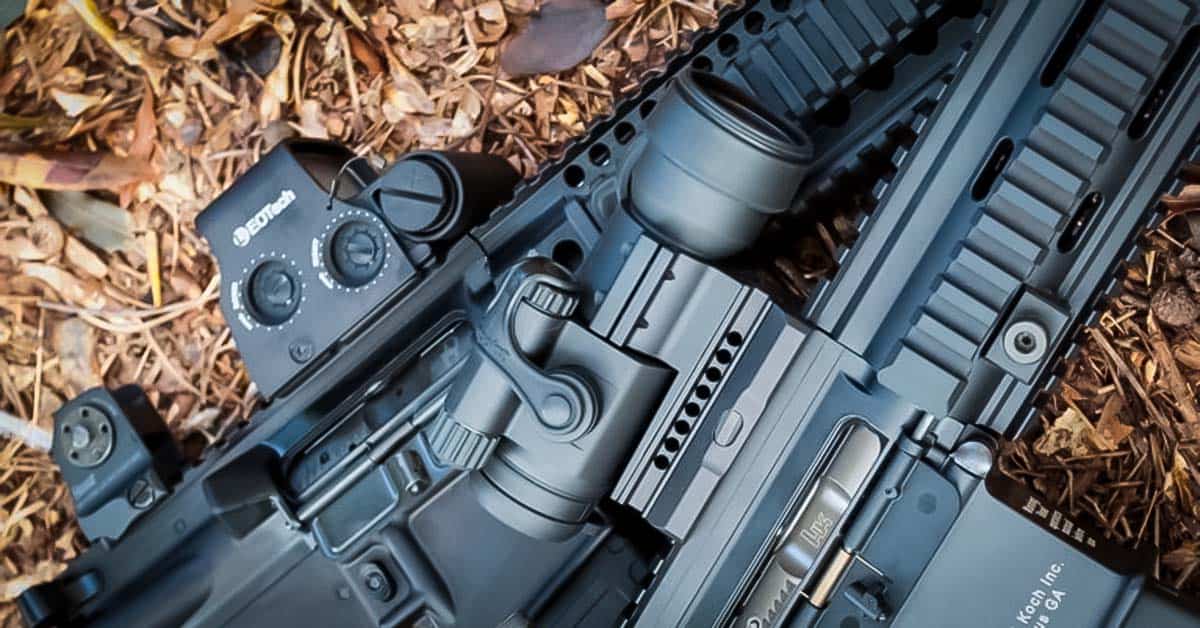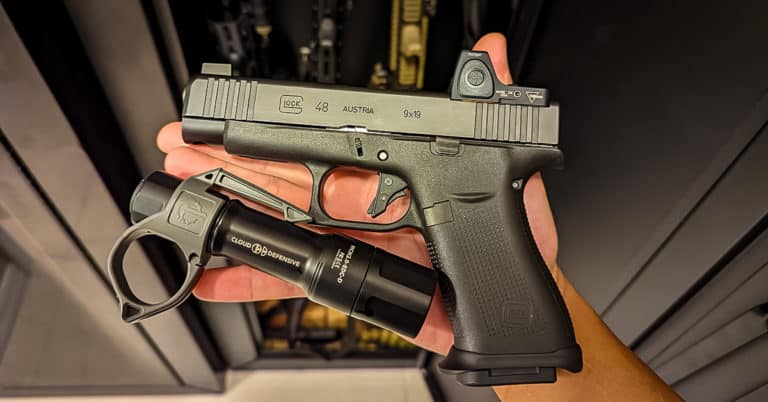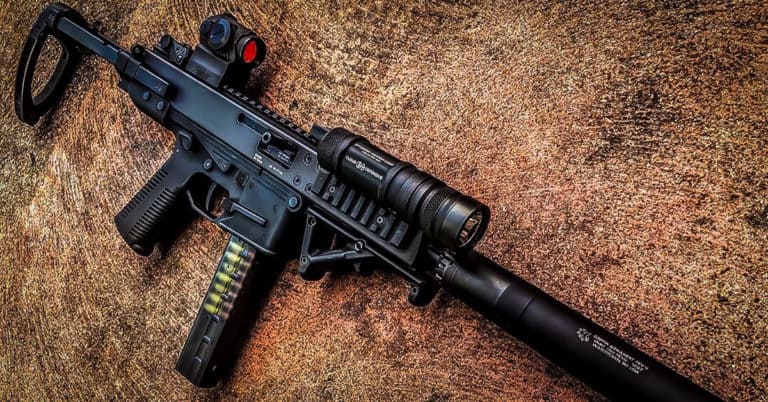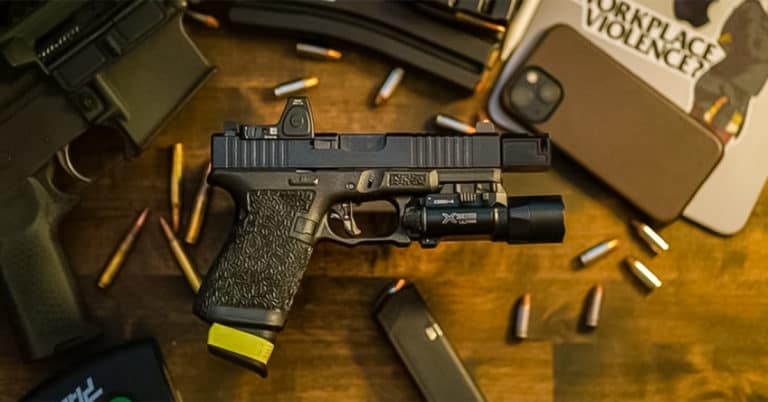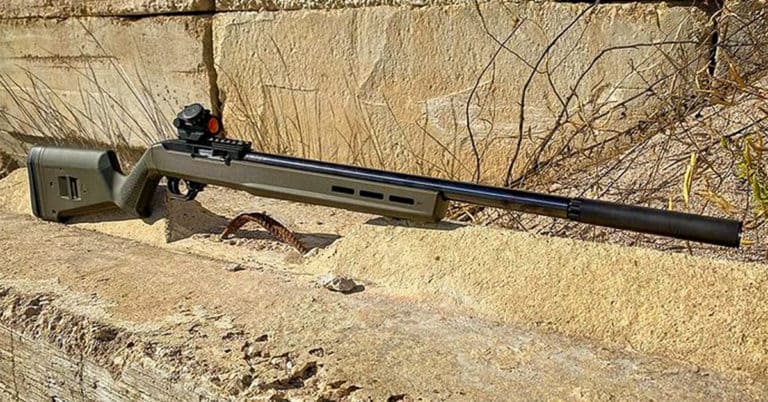Red Dot vs Holographic Sights (Complete Guide)
Red dot vs holographic sight? The age-old question that is always up for debate.
When choosing a sight for your firearm, you might wonder about the differences between red dot and holographic sights and which one is best for you.
They both allow you to aim faster, be more precise with your shots, and give you an advantage compared to regular old iron sight—slap on a magnifier, and now your cooking.
It’s a good time to be alive as a gun owner.
This post will take an in-depth look at red dots and holographic sights and explain the difference in great detail.
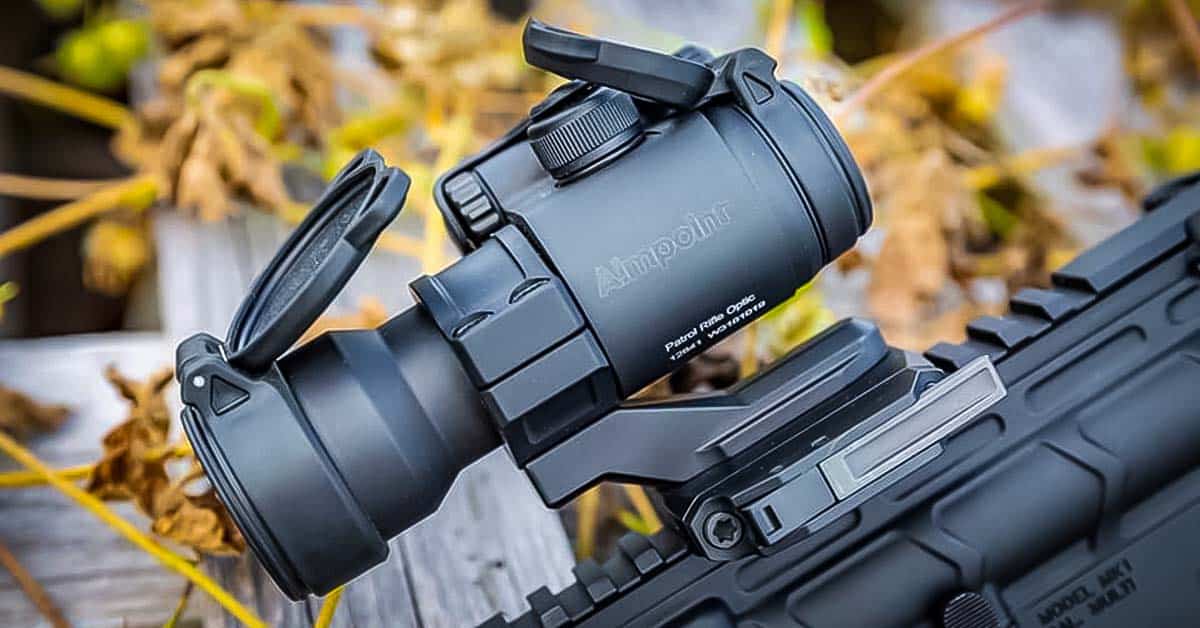
What Is A Red Dot Sight
A red dot sight is a type of sight that utilizes an LED (light-emitting diode) to project an illuminated red dot onto a transparent glass. This red dot is then reflected back to the eye of the user and is used as an aiming point for the firearm.

It is a simple and intuitive system that allows for fast target acquisition and can be used for various shooting scenarios.
Red dot sights don’t have magnification features like traditional scopes, but they have adjustable brightness levels, which can be used in different lighting conditions.
They are generally easy to use and can be mounted on various firearms, including rifles, shotguns, and handguns.
What Is A Holographic Sight
A holographic sight is a type of sight that utilizes a laser diode to project a hologram of an aiming point onto a transparent glass.
The hologram is then superimposed in the distance when looking through the field of view (FOV), allowing the user to simultaneously see both the target and the holographic reticle.
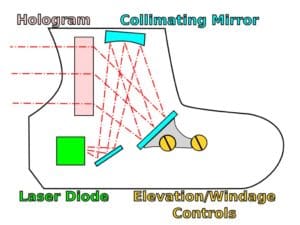
Unlike red dot sights, holographic sights offer a wider field of view and can be used in various lighting conditions.
Holographic sights are known for their advanced technology and complex manufacturing process, making them more expensive than red dot sights.
They also have features like multiple reticle options, adjustable brightness, and windage and elevation adjustment, which makes them versatile and suitable for different shooting scenarios.
The holographic sight reticle will often have more information, such as bullet drop compensation. The EOTech holographic sight reticle is well known for this.
Red Dot VS Holographic Sights
Here is a quick overview…
There are a few things to consider regarding red dot sights (RDS) and holographic weapon sights (HWS). Red dot sights use a collimating mirror to create the dot, which can appear blurry or distorted to those with astigmatism.
A magnifier can also cause additional aberrations for those with astigmatism.
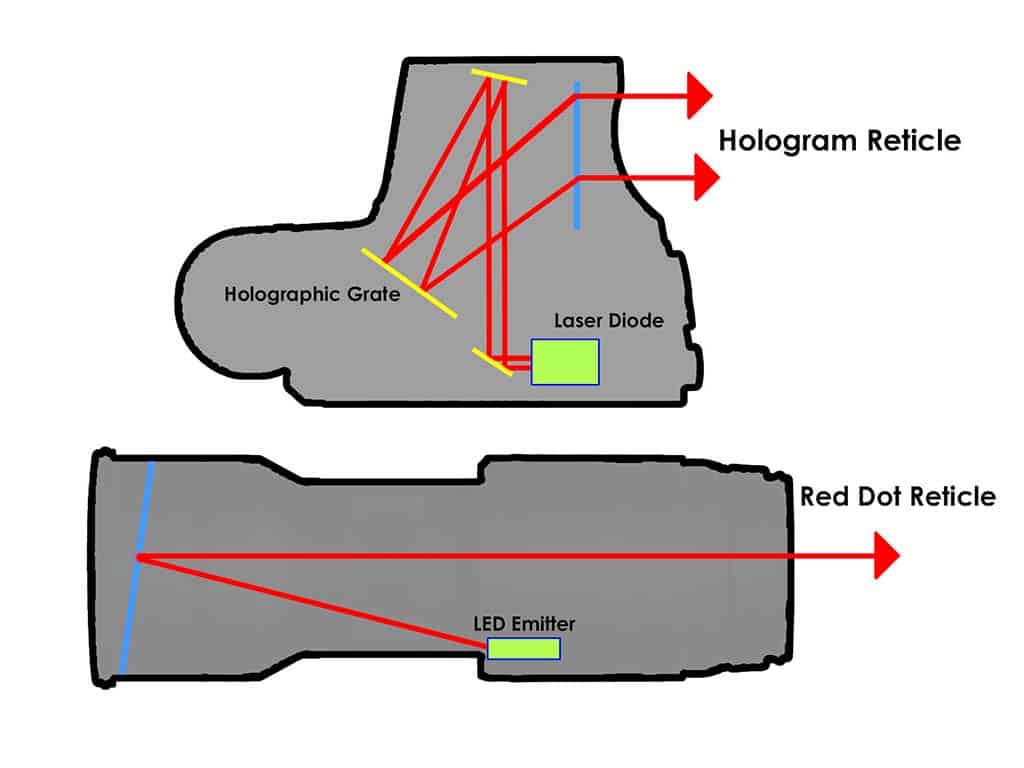
HWS uses a holographic grate to create the reticle, which can appear less distorted to those with astigmatism. But it should be remembered that HWS isn’t completely free of astigmatic aberrations.
Prism-based optics tend to have less aberration as they use lenses and etched glass to create the reticle instead of collimating mirrors or holographic grates.
Regarding target acquisition, keeping both eyes open and focused on the target rather than the dot or reticle can help improve engagement times and accuracy. This is known as ‘binocular vision’ or ‘stereopsis.’
Price is another factor to consider, many top-of-the-line RDS and HWS are great, but for most civilian shooters, lower-cost options can be a great and reliable choice without breaking the bank.
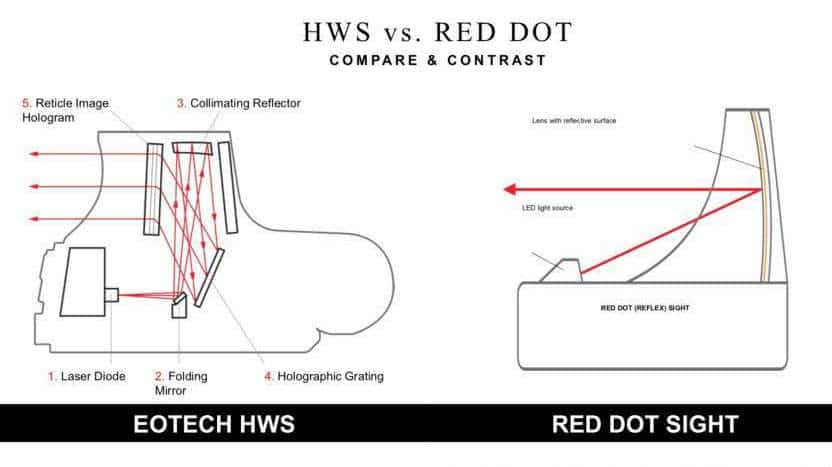
Most red dot sights and holographic sights will have a red reticle. There are some options with a green reticle on both, but it is not as common.
There are good options available at all price points.
It’s worth mentioning that the size of the dot does not change with the use of a magnifier.
That is just a quick explanation but now let’s get into the meat and potatoes of the topic.
Price
Choosing a sight for your firearm can be tricky, with many factors to consider, but one of the most significant differences is the price tag between red dot sights and holographic sights.
While red dot sights are more budget-friendly, holographic sights come with a premium price tag.
The manufacturing process is one of the main reasons for the price difference.
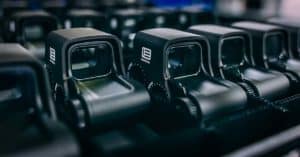
Red dot sights are typically less complex, and many manufacturers are in the market, making them more affordable. On the other hand, holographic sights come with advanced technology and require a more intricate manufacturing process which contributes to the higher price point.
Additionally, the market is dominated by only a few manufacturers, which affects the cost.
It ultimately comes down to personal preference, budget, and intended use of the sight. A red dot sight may be the way to go if you’re looking for an affordable option.
But if you’re willing to invest in advanced technology, be prepared to pay a premium price for a holographic sight.
Magnification & Power
Red dot sights typically do not have a magnification feature. They have a non-magnifying 1x power, which means that the image seen through the sight is the same size as the actual target.
This allows for quick and easy target acquisition, making them ideal for close-range and fast-moving targets.
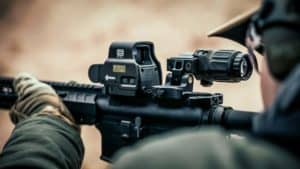
Some brands of red dots may have a 1.1x magnification when looking through them. Most people will not notice, but others can be turned off by certain types of red dots that are not a true 1x and find it distracting.
On the other hand, holographic sights typically come with 1x magnification, but some models can have the capability of 1.5x or 2x magnification.
This means the image seen through the sight will be magnified 1.5 or 2 times the actual size of the target, allowing for better accuracy at a more extended range.
However, unlike traditional scopes, holographic sights offer a wider field of view, allowing for faster target acquisition and better situational awareness.
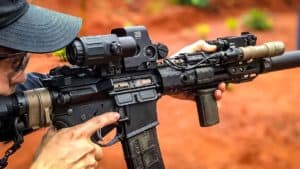
Red dot sights do not have a magnification feature. They are non-magnifying with 1x power, while Holographic sights typically come with 1x magnification, and some models can have a magnification of 1.5x or 2x.
The holographic sight offers a broader field of view, which makes it suitable for different shooting scenarios.
Both can be increased by adding a magnifier in front of the optic, which I will get into later in this post.
Reticle Size & Type
When it comes to reticle and size options, there are some differences between red dot sights and holographic sights.
Red dot sights typically have a red dot reticle that is adjustable in size, with the most common size options being 1 MOA, 2 MOA, and 4 MOA. A smaller MOA size, like 1 or 2, will give a more precise aim point but will be harder to see in low-light conditions.
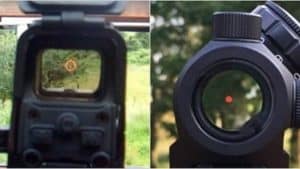
A larger MOA size, like 4, will be easier to see in low-light conditions but will give a less precise aim point.
On the other hand, holographic sights have more reticle options in addition to the red dot reticle.
Some popular reticle options include the cross-hair, circle dot, and triangle reticles. They also come with different reticle patterns projected on the lens and not etched on the glass like in red dot sights.
Size & Weight
The size and weight of red dot sights and holographic sights can vary between models, but in general, red dot sights tend to be smaller and lighter than holographic sights.
Red dot sights are designed to be compact and lightweight, with most models measuring around 2-3 inches in length and weighing less than 4 ounces. This makes them ideal for use on pistols, rifles, and shotguns, as well as for adding to other accessories.

On the other hand, Holographic sights tend to be bulkier and heavier than red dot sights. They often measure around 3-4 inches in length and can weigh up to 10 ounces or more.
This makes them more suitable for use on rifles but less practical for use on pistols.
Build Quality
The build quality of red dot sights and holographic sights can vary between manufacturers and models. Still, holographic sights generally have better build quality than red dot sights.
That is not always the case; some high-end premium red dots are bombproof.
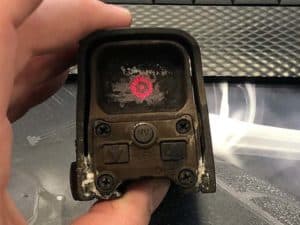
Holographic sights are built with higher-grade materials and more advanced technology, which gives them a more durable construction and greater resistance to recoil, impacts, and extreme temperatures.
They also have a more complex construction, which makes them more durable.
On the other hand, red dot sights have a more straightforward construction and are typically built with lower-grade materials.
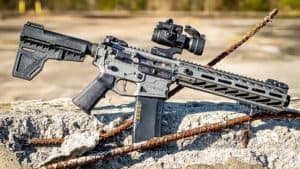
This can make them less durable and more prone to damage from recoil, impacts, and extreme temperatures.
It’s also worth noting that the quality of red dot sight has improved over the years. Many manufacturers now use better-quality materials, and some models can be very durable.
Battery Life
The battery life of red dot sights and holographic sights can vary between manufacturers and models. Generally, red dot sights tend to have a longer battery life than holographic sights.
Red dot sights use a LED (light-emitting diode), which typically lasts a very long time, upwards of 50,000 hours or even more. This means you may only need to change the battery once or twice a year, even with heavy use.

Holographic sights, on the other hand, use a laser diode which requires more energy to function and as a result, have a shorter battery life.
Many models will last for around 500-1000 hours before needing to be replaced, depending on the brand and model.
It’s also worth noting that some manufacturers have implemented an auto-shutoff feature on the sight, which will turn off the sight after a certain time period of inactivity, which will prolong the battery life.
Astigmatism
For individuals with astigmatisms, the differences between red dot sights and holographic sights can impact the perceived clarity and accuracy of the sight’s reticle or dot.
Red dot sights create the dot or reticle by using a collimating minating mirror which causes the light that creates the dot to be refracted into multiple focal points.
This can result in a blurry, distorted, or “bursting” dot for people with astigmatisms, making it difficult to acquire and maintain a sight picture of the target.

Holographic sights use a different method. The laser diode illuminates a hologram of an aiming point superimposed in the distance when looking through the FOV.
The holographic grate of the holographic sight has a side effect that acts as a polarizing filter, which restricts the light rays that enter the eye to only those that are direct and parallel with other light rays, so as a result, it will reduce some of the aberrations for people with astigmatism.
While many individuals with astigmatisms may find holographic sights to be less distorted than red dot sights, it’s worth noting that both types of sights can produce aberrations for those with astigmatisms.
A holographic sight will be better for you if you suffer from astigmatism.
Parallax
Parallax in red dot sights and holographic sights refers to the apparent movement of the reticle or dot in relation to the target as the viewer’s head or eye position changes.
It occurs when the aiming point and the target are not on the same optical plane.
Red dot sights usually have minimal parallax, meaning that the dot will remain relatively still as the user’s eye or head position changes, making it easier to maintain a sight picture of the target. However, some budget-friendly red dots might have more pronounced parallax
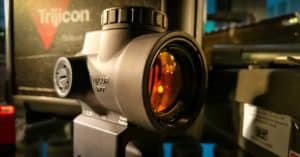
Holographic sights also have minimal parallax because the hologram is projected on the same plane as the target.
This means that it remains in focus as the user’s eye or head position changes, making it easier to maintain a sight picture of the target, which is one of the reasons why some shooters prefer them.
When choosing an optical weapon sight, “parallax-free” means that the reticle or dot will remain in the same position relative to the target, regardless of the viewer’s eye position.
This is important because it ensures that the reticle or dot will stay aligned with the target, making it easier to aim and hit the target accurately.
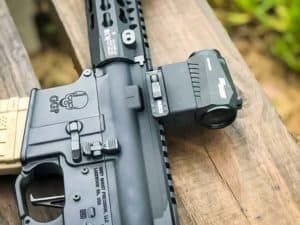
Many high-end optical weapon sights, including both red dot sights and holographic sights, are designed to be parallax-free.
However, not all sights, particularly budget-friendly options, are parallax-free, so it’s important to check the specifications of the sight before making a purchase.
Related Articles
Field Of View
The field of view (FOV) in red dot sights and holographic sights refers to the amount of area visible through the sight. It is usually measured in degrees or feet at a specific distance, usually 100 yards.
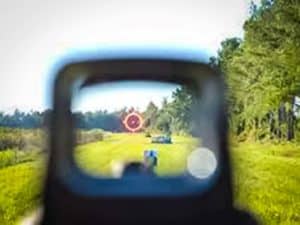
The most popular holographic sight are EOTechs, and they have a wide rectangular field of view which most people prefer.
Some red dots are usually narrow and give the feeling of looking through a small tube, but it depends on which manufacturer or brand optic you are considering.
With Magnifier
When using a magnifier alongside a red dot sight or a holographic sight, the reticle may appear larger and clearer with the holographic sight than with the red dot sight.
This is due to the nature of the reticle projected in a holographic sight, which is created by a laser diode illuminating a hologram of an aiming point, whereas a red dot uses an LED to project an aiming point onto the glass.

The laser diode illumination on the holographic reticle allows for a clearer, crisp, and more defined image, which can be further amplified using a high-quality magnifier lens.
On the other hand, red dots tend to be less complex and less defined than holographic ones, so using a magnifier will increase the size but not the clarity of the reticle.
However, the quality of the reticle clarity depends on the quality of the magnifier lens and the quality of the red dot sight itself, so it’s important to note that not all red dot sights and magnifiers will provide the same level of clarity when used together.
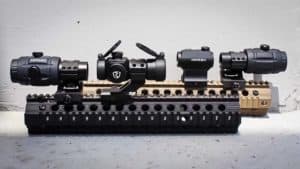
High-end red dot sights with high-quality glass, lens coatings, and a high-quality magnifier will provide a crisp and bright reticle, making it easier to aim and hit long-range targets.
Acquisition Speed
Both red dots sights and holographic sights are way faster than iron sights. This is because the reticle is superimposed in the distance, allowing you to quickly acquire the target without aligning anything.
Both of them also allow for faster target acquisition for both eyes open, which makes it easier to track moving targets.
Holographic sights are slightly faster due to how they work, but the difference isn’t noticeable to the average person.
Night Vision
red dot reticles are typically projected on the same plane as the target, which can make the reticle less visible when using night vision goggles.
But if your optic is night vision compatible, it will have settings that will work alongside night vision devices.
The holographic sight will be slightly clearer and brighter when using night vision.
Red Dot VS Holographic Sight Pros & Cons
One of the main advantages of red dot sights is that they are typically more budget-friendly than holographic sights.
They also tend to be simpler in design and offer various options and variations.
Regarding cons, they typically have a smaller field of view and may not offer the same level of clarity and brightness in low-light conditions as a holographic sight.
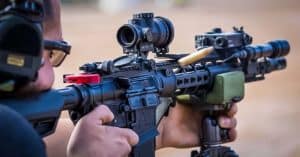
On the other hand, holographic sights offer advanced technology and features, such as a laser-projected reticle that is projected in front of the sight and stays focused when you look downrange, allowing faster target acquisition and better visibility in low light conditions.
They also typically have a wider field of view. However, the main disadvantage is that they are more expensive than red dot sights and have shorter battery life.
Holographic Sight VS Red Dot: Which is Better?
Holographic sights are often more expensive, bulkier, and heavier. Their batteries don’t last as long, but I believe they are worth it. Holographic sights give you lightning-fast target acquisition, and the reticle is in focus and clear as day.
If you abuse your gear and don’t baby it, holographic sights will still function with damage and a broken front lens.
Some of the Gucci Holo sights even have range finders built in. If you have astigmatisms, holographic sights will not slow you down.
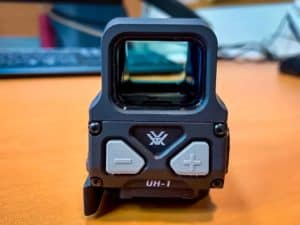
Red dots are quickly becoming the standard choice for most people, and the days of iron sights are over. Red dot sights are generally more affordable, very compact, lightweight, and give insanely long battery life.
They can be more fragile than holo sights, but they are still pretty damn tough if you get a good one. If the front lens is damaged, it becomes unusable.
If you still can’t decide after reading this, get what you think looks cooler (joking but somewhat serious). I’m willing to bet that both options will serve you well, no matter your choice.
If you can afford it, get them both.
Final Thoughts
Holographic sight or red dot sight, no matter which one you decide, make sure it is a good one. You get what you pay for, especially when it comes to firearm optics.
Most red dot sights will start at around $200 and go up from there. EOTech holographic sights will start around $450.
The EOTech holographic sight is very reliable and has a good reputation.
Traditional red dot sights have come a long way and are improving. The battery life on them is insane. Most red dot sights will have an extreme battery life.
Prism sights and reflex sights were not mentioned, but I will publish a post on them in the future.
Thank you for reading, and I hope this article was helpful!
Please send it to a friend or share it on social media if you found it helpful.
A lot of time and effort went into creating this; as a reader, it greatly helps us create more content like this.
Also, if you notice any errors or wrong information in this article, please comment below so it can be corrected.
Red Dots vs. Holographic Sights FAQ
What is the difference between a red dot sight and a holographic sight?
A red dot sight projects a red dot onto a piece of glass, which the shooter looks through to aim. A holographic sight uses a laser and a holographic image to create a reticle that appears to be floating in front of the shooter. Holographic sights tend to have slightly more complex reticle patterns, including multiple dots, crosshairs, or even a circle-dot reticle.
Which is better for long-range shooting, a red dot or a holographic sight?
Both red dot and holographic sights can be used for long-range shooting, but the holographic sights tend to be slightly more versatile due to the wide field of view and ability to use the reticle in both eyes. Red dot sights are typically better for close-range shooting and quick target acquisition.
Can a holographic sight be used with both eyes open?
Yes, one of the benefits of a holographic sight is that it allows for both eyes open shooting, which can improve target acquisition and situational awareness.
Do red dots, and holographic sights work with night vision goggles?
Some red dot and holographic sights are night vision compatible and have special reticle patterns that can be seen with night vision goggles. However, many standard red dots and holographic sights cannot be used with night vision goggles.
Are red dot and holographic sights more durable than traditional scopes?
Red dot and holographic sights are generally more durable than traditional scopes as they don’t have any moving parts. These sights also tend to be shockproof, waterproof, and fog proof. However, the quality of the sight and the construction material will be the biggest factor in determining its overall durability.
Further reading on Firstworldcrusader.com: Are you interested in learning more about guns and gear?
This list of the Best Red Dot Sights can help you choose the best optic for your rifle.
In addition, here are the Best AR-15 Upgrades & Accessories that can help you get more out of your primary battle rifle.

